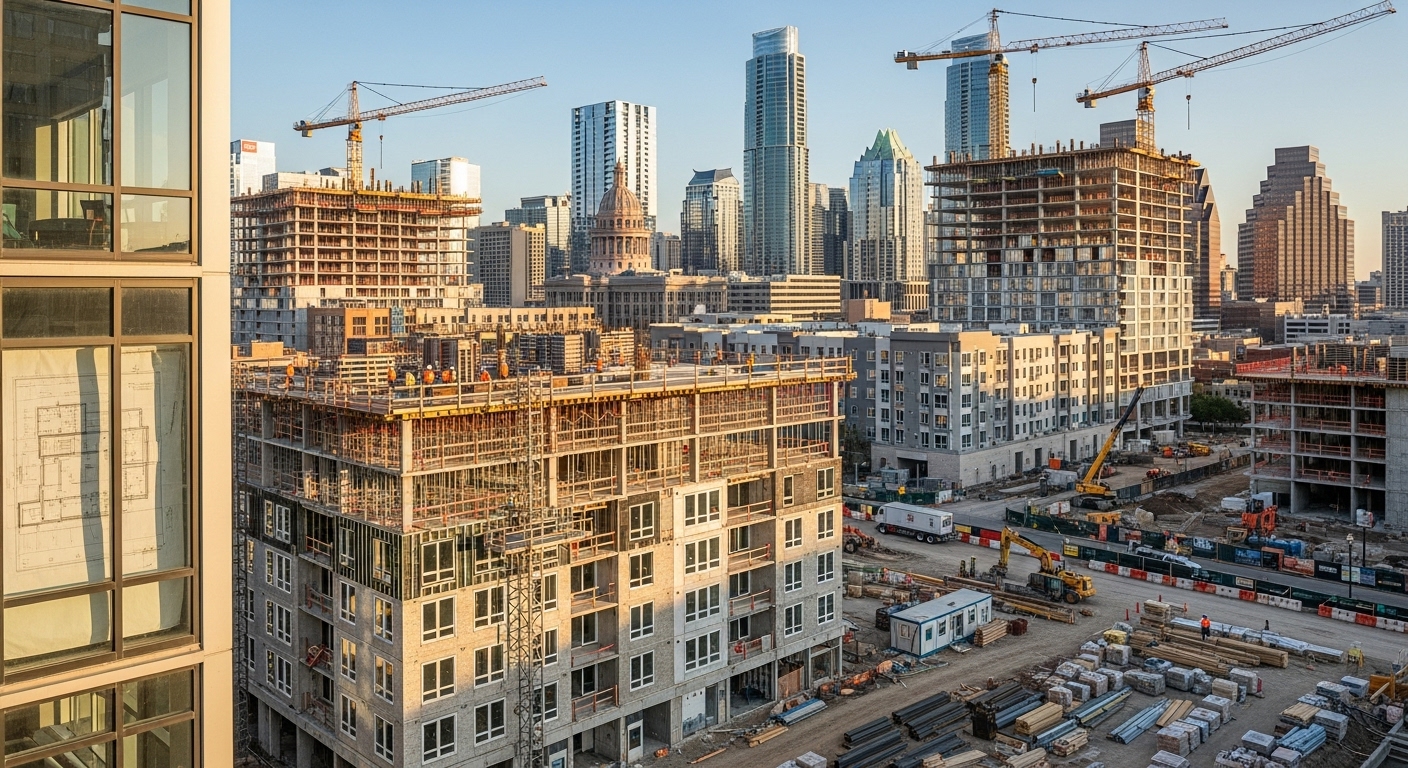Austin’s Multi-Family Construction Boom: Strategic Upgrade Solutions for Property Owners
Austin’s construction landscape is experiencing unprecedented growth, with multi-family property owners at the center of a transformative period. As the city continues its rapid expansion, property owners face unique challenges and opportunities that demand strategic renovation approaches and phased upgrade projects to maximize returns while maintaining operational continuity.
Austin’s Construction Market: A Hub of Opportunity
The Austin construction market has emerged as one of Texas’s most dynamic sectors, with recent developments highlighting the city’s commitment to infrastructure growth. From the $1.5 billion Capitol Complex expansion to major university projects like the groundbreaking of Mulva Hall’s 17-story academic tower, Austin demonstrates sustained investment in large-scale construction initiatives.
This growth directly impacts multi-family property owners, creating both opportunities for portfolio expansion and pressure to maintain competitive properties. With institutional and commercial project starts rebounding despite ongoing material cost challenges, the market signals strong demand for strategic property improvements.
The Multi-Family Renovation Challenge in Austin
Multi-family property owners in Austin face a complex construction environment characterized by:
Rising Material Costs and Supply Chain Pressures
Construction across Texas, including Austin, is experiencing higher material costs and tariff-driven supply challenges. These factors make strategic planning and phased renovation approaches essential for maintaining profitability.
Labor Shortage Solutions
The North America’s Building Trades Unions recently brought their Opportunity Pipeline Tour to Austin, highlighting efforts to address skilled labor shortages. This initiative underscores the importance of working with established contractors who have strong workforce relationships.
Occupied Environment Challenges
Unlike new construction projects, multi-family upgrades must often occur while tenants remain in place, requiring specialized expertise in construction management within occupied environments.
Strategic Phased Upgrade Approaches
Successful multi-family renovation projects in Austin’s competitive market require careful planning and execution. Property owners benefit from adopting systematic approaches that minimize disruption while maximizing returns.
Four-Phase Strategic Process
Phase 1: Assessment and Planning
Professional property condition assessments identify priority areas requiring immediate attention versus long-term improvements. This phase includes capital needs assessments to establish realistic budgeting and timeline expectations.
Phase 2: Infrastructure and Systems
Critical upgrades to HVAC, plumbing, and electrical systems form the foundation of successful renovations. These improvements often provide the highest return on investment while addressing tenant comfort and safety requirements.
Phase 3: Unit Refresh and Room Turns
Strategic unit renovations maximize occupancy rates and rental premiums. Professional room turn services ensure minimal vacancy periods while delivering high-impact aesthetic improvements.
Phase 4: Common Areas and Amenities
Final phases focus on community spaces that differentiate properties in Austin’s competitive rental market, including fitness centers, community rooms, and outdoor spaces.
Construction Management in Occupied Environments
Multi-family renovation projects present unique logistical challenges that require specialized expertise. Successful projects maintain operational continuity while delivering substantial improvements.
Tenant Communication Strategies
Clear, consistent communication with residents reduces complaints and maintains positive tenant relationships throughout renovation periods. Professional construction management includes comprehensive communication plans.
Scheduling and Coordination
Phased construction schedules minimize disruptions to daily operations while ensuring efficient resource utilization. This approach reduces overall project timelines and costs.
Quality Control Measures
Rigorous quality standards ensure renovations deliver lasting value without requiring costly repairs or adjustments. Professional oversight prevents common construction issues that could impact tenant satisfaction.
Austin Market Trends Impacting Multi-Family Properties
Recent developments in Austin construction provide valuable insights for property owners planning renovation projects:
Emergency Response Infrastructure
The city’s rapid delivery of new fire and EMS stations demonstrates municipal commitment to supporting population growth, enhancing property values in served areas.
Convention and Tourism Growth
The Austin Convention Center redevelopment signals continued economic growth that benefits rental markets and supports premium pricing for well-maintained properties.
Educational Sector Expansion
Major university construction projects like Mulva Hall contribute to strong rental demand, particularly in areas serving student and faculty populations.
Risk Mitigation in Construction Planning
Recent flooding across Central Texas, including the Austin area, highlights the importance of resilient infrastructure planning. Property owners must consider environmental risks when planning major renovations.
Weather-Resistant Upgrades
Strategic improvements to drainage, roofing, and building envelope systems protect long-term investments while reducing insurance costs.
Emergency Preparedness Integration
Renovation projects provide opportunities to enhance emergency response capabilities, including improved lighting, communication systems, and evacuation routes.
Financial Considerations for Phased Renovations
Austin’s construction market conditions require careful financial planning for multi-family renovation projects. Property owners benefit from understanding current market dynamics and cost factors.
Budget Planning Strategies
Professional bid reviews and contractor audits ensure accurate cost estimates and prevent budget overruns. Independent third-party assessments provide objective evaluation of proposed work.
Timeline Management
Phased renovation approaches allow property owners to spread costs over time while generating rental income from improved units. This strategy improves cash flow management during major upgrade periods.
Return on Investment Optimization
Strategic prioritization of renovation elements maximizes rental increases and property value improvements. Professional project evaluation ensures focus on highest-impact improvements.
Choosing the Right Construction Partner
The complexity of multi-family renovation projects in Austin’s dynamic market requires experienced construction management expertise. Property owners benefit from partners who understand both construction challenges and property management requirements.
Industry Experience Requirements
Successful multi-family renovation requires specific expertise in occupied environment construction, tenant relations, and property management coordination.
Local Market Knowledge
Understanding Austin’s specific construction challenges, permitting requirements, and market trends ensures project success and compliance with local regulations.
Transparent Communication Standards
Clear communication throughout all project phases maintains positive tenant relationships while keeping property owners informed of progress and any necessary adjustments.
Future-Proofing Multi-Family Investments
Austin’s continued growth trajectory makes strategic property improvements essential for maintaining competitive positions in the rental market. Property owners who invest in comprehensive upgrade programs position their properties for sustained success.
Technology Integration
Modern renovation projects incorporate smart building technologies that appeal to tech-savvy Austin tenants while reducing operational costs.
Sustainability Features
Energy-efficient upgrades reduce operating expenses while appealing to environmentally conscious renters, supporting premium rental pricing.
Flexible Space Design
Renovation approaches that create adaptable living spaces respond to changing tenant preferences and market demands.
Conclusion
Austin’s booming construction market presents significant opportunities for multi-family property owners who approach renovations strategically. With material costs and labor challenges creating market pressures, the importance of professional construction management and phased upgrade approaches cannot be overstated.
Success in this environment requires partners who combine construction expertise with deep understanding of property management requirements. By focusing on strategic planning, transparent communication, and quality execution, property owners can navigate Austin’s dynamic market while maximizing returns on renovation investments.
The key to successful multi-family renovation lies in recognizing that these projects are not just construction activities, but strategic business initiatives that require specialized expertise and careful execution. As Austin continues its rapid growth, property owners who invest in professional renovation approaches will be best positioned to capitalize on the city’s expanding rental market opportunities.


0 Comments